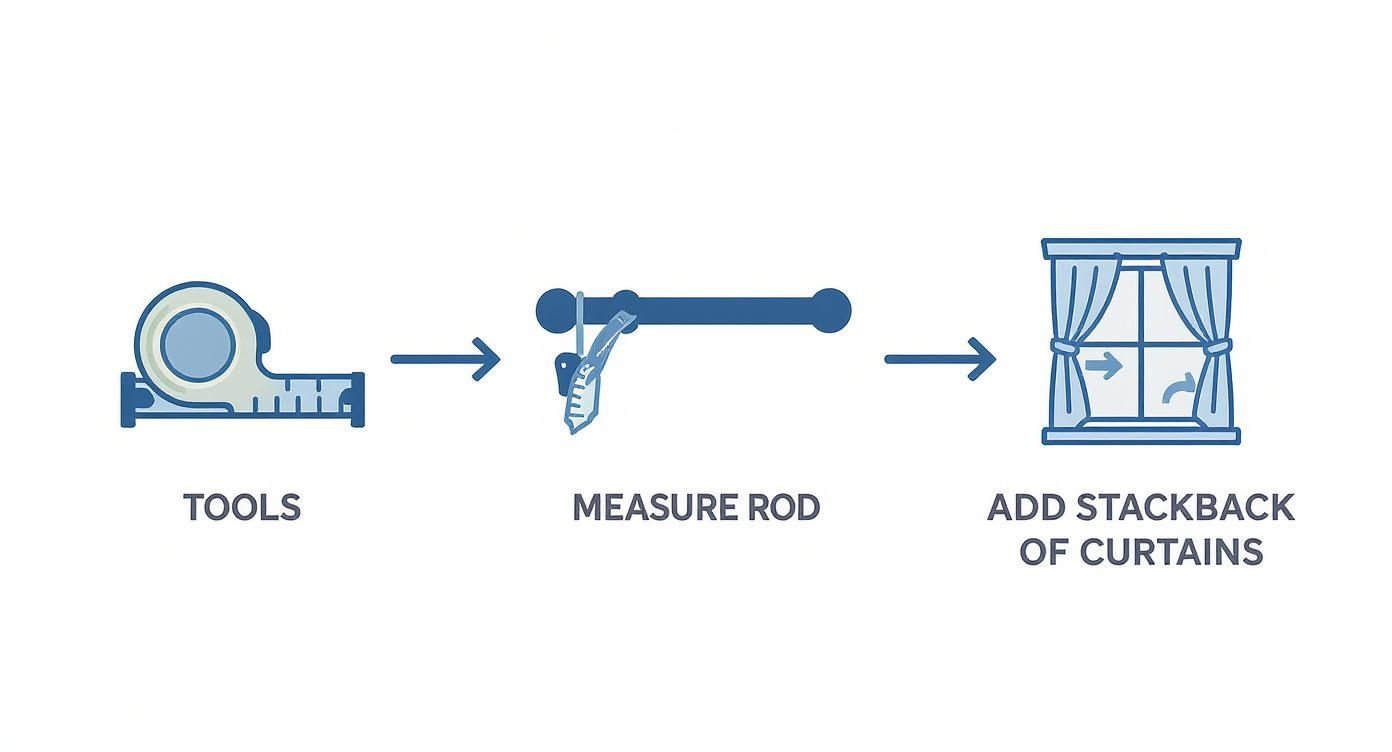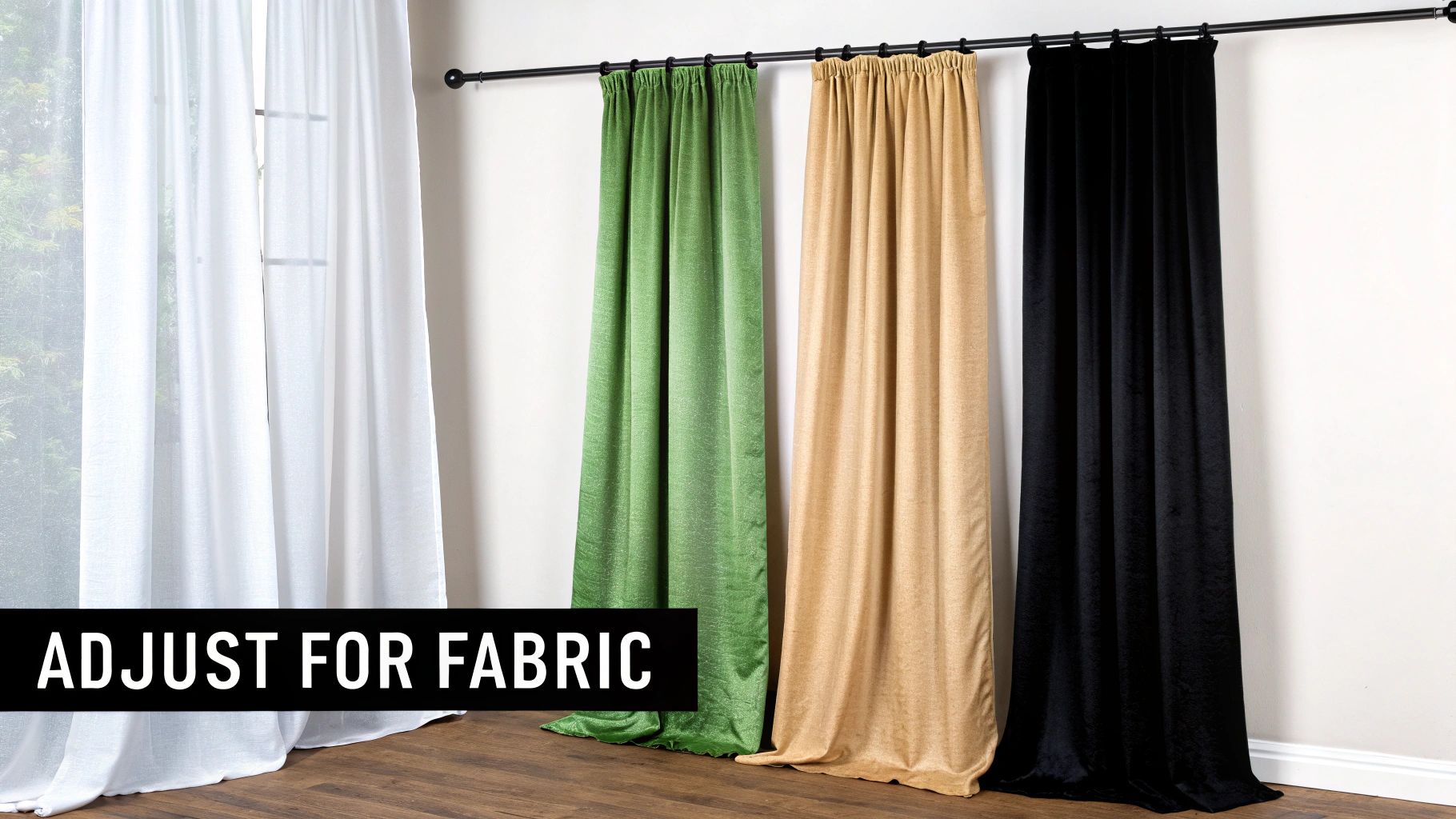
How to Calculate Curtain Width for a Perfect, Polished Look
Getting your curtain width right separates a custom, high-end look from a design that falls flat. The simple answer is this: your total curtain width should be 2 to 3 times the width of your curtain rod. This measurement, called 'fullness,' is the secret to ensuring your curtains have beautiful, flowing folds.
This guide will walk you through the exact steps to calculate curtain width, choose the right fullness for different fabrics, and avoid common mistakes.
Table of Contents
- Why Curtain Fullness is The Secret to Perfectly Dressed Windows
- First Things First: Getting Your Tools and Measurements
- The Curtain Width Formula Explained
- Adjusting for Different Curtain Styles and Fabrics
- Common Curtain Measurement Mistakes to Avoid
- Frequently Asked Questions
Why Curtain Fullness is The Secret to Perfectly Dressed Windows
Have you ever hung new curtains only to feel... underwhelmed? When closed, they look like a flat sheet rather than the lush, elegant drapes you envisioned. This common design hiccup almost always comes down to not having enough fabric width.
To calculate curtain width correctly, you must aim for fullness. Matching your curtain panel width to your window's width is a recipe for a stiff, awkward look. The goal is to create beautiful, consistent pleats that add depth, texture, and luxury.

More Than Just Looks
Proper fullness isn't just about aesthetics; it brings serious functional benefits. When curtains have enough width, they provide:
- Better Light Control: Fuller curtains are much better at blocking light from seeping through the edges, a must for bedrooms or media rooms.
- Enhanced Privacy: Properly sized panels ensure there are no gaps for outsiders to peek through when the curtains are drawn.
- Improved Insulation: The air trapped within deep folds acts as a natural insulator, helping to regulate room temperature.
The widely accepted rule is that the total curtain width should be 2 to 3 times the width of the rod. For a standard gathered appearance, a 2x multiplier is perfect. For a more luxurious, ultra-full effect, lean toward a 3x multiplier. You can read the full research about these market standards to understand the professional approach.
Pro Tip: When in doubt, it's always better to go wider. Too much fullness can be managed and still look elegant, but too little fabric will always look cheap and unfinished.
Understanding this foundational principle sets you up for success. Knowing why width matters will change how you approach your window dressing project, guaranteeing a flawless result every time.
First Things First: Getting Your Tools and Measurements
Before thinking about curtain fullness, you need a rock-solid starting point. Nailing the initial measurement is the most important step to getting that polished, professional look.
For this job, a steel retractable measuring tape is non-negotiable. Its rigidity provides a straight, precise line every time. You'll also want a pen and paper (or your phone's notes app) and possibly a step ladder for high windows.
Measure the Curtain Rod, Not the Window
A common rookie mistake is measuring the window frame itself. To calculate your curtain width correctly, you must measure the width of your curtain rod or track. Measure the distance from one end bracket to the other, excluding any decorative finials.
If you haven't installed a rod yet, you can create a more dramatic look. A fantastic designer trick is to install the rod so it extends 3 to 6 inches past the window frame on each side. This simple move makes the window feel much larger and grander.
Of course, the rod is just one piece of the puzzle. Understanding all components—brackets, finials, and rings—is key. For a deeper dive, you can Learn more about essential hardware and ironmongery to ensure you're picking the right parts.
Why "Stack Back" Is a Game-Changer
Now, let's talk about a crucial concept called stack back. It’s simply the space your curtains take up when they're fully open and pushed to the sides. If your rod is only as wide as your window, those "stacked" curtains will block a portion of the glass, cutting off natural light.
By extending your curtain rod beyond the frame, you give the curtains their own "parking spot" on the wall. This allows the fabric to stack neatly, leaving your window unobstructed when the curtains are open. It’s a small detail that makes a massive difference in how open and bright your room feels.
Key Takeaway: Always measure the rod, not the window glass. Extend your rod at least 3-6 inches past the frame on both sides to maximize light and create the illusion of a larger window. For a more detailed guide, check out our article on how to measure windows for curtains.
The Curtain Width Formula Explained
Alright, you've got your rod measurement. Now for the fun part: turning that number into beautifully full curtains. The great news is you don't need to be a math whiz. We're going to break down one simple formula that removes all the guesswork.
This is your go-to calculation for any window project. Once you understand its three simple parts, you can confidently figure out your curtain needs every time.
The Core Calculation for Curtain Width
At its heart, the formula balances your rod's length with how lush you want the curtains to look. Then, we'll divide that by the number of panels you plan to hang. This simple math ensures each panel has enough fabric to create gorgeous, rich pleats.
The Curtain Width Formula:
(Curtain Rod Width x Fullness Multiplier) ÷ Number of Panels = Ideal Width Per Panel
Each piece of this puzzle is critical. The rod width is your starting line, the fullness multiplier defines the final look, and the number of panels tells you what size to shop for. If one of these numbers is off, the whole look can fall flat.
Putting the Formula into Practice
Let's walk through a real-world example. Imagine you have a large window with a curtain rod that measures 100 inches. You’re aiming for a classic look, so a 2x fullness multiplier is perfect. You also want two curtain panels, one for each side.
Here’s how the math breaks down:
- First, multiply your rod width by the fullness: (100 inches * 2) = 200 inches. This is the total fabric width you need.
- Next, divide that total width by your number of panels: 200 inches ÷ 2 panels = 100 inches per panel.
It’s that simple. You need two curtain panels that are each at least 100 inches wide. If you accidentally bought two 50-inch panels, they would hang completely flat when closed. For extra-large openings, learning about the right curtain width for a sliding glass door can help fine-tune this for unique spaces.
This infographic breaks down the measurement steps leading into this formula.

As you can see, grabbing the right tools and getting an accurate rod measurement—including that crucial stack back—are the foundational steps. Getting this prep work right ensures your final calculation is built on solid, practical numbers.
Adjusting for Different Curtain Styles and Fabrics
The standard fullness formula is a fantastic starting point, but it's not the whole story. A truly professional finish lies in the details—specifically, the header style and the fabric you choose.
A sleek grommet-style curtain creates wide, uniform waves and doesn't need much extra fabric. On the other hand, a classic pencil pleat heading needs more material to create its tight, dense gathers. Ignoring these differences can make your curtains look skimpy or overwhelmingly bulky.

Fine-Tuning for Header Styles
Different headers create distinct visual effects, and each has an ideal fullness multiplier. For instance, certain heading types, like those in White Sheer Window Grommet Curtain Sets, create a specific drape that impacts how much fullness you’ll need.
Here’s a quick guide to tweak your formula for the most common styles.
Fullness Adjustments for Curtain Header Types
The header dictates the pleating and overall shape, which means each style needs a different amount of fabric to look its best.
| Header Style | Recommended Fullness Multiplier | Visual Effect |
|---|---|---|
| Rod Pocket | 2.5x to 3x | Creates dense, soft gathers for a traditional look. |
| Pencil Pleat | 2.5x to 3x | Forms tight, uniform pleats like a row of pencils. |
| Grommet/Eyelet | 1.5x to 2x | Produces wide, consistent, S-shaped folds. |
| Tab Top | 1.5x to 2x | Results in gentle, informal pleats. |
| Pinch Pleat | 1.5x to 2x | Structured, sewn-in pleats create a tailored finish. |
| Box Pleat | 2x to 2.5x | Offers a formal, crisp look with wide, flat pleats. |
Choosing the right multiplier ensures your curtains drape beautifully without looking overstuffed or sparse.
How Fabric Weight Changes the Game
The type of material you choose is just as important as the header style. A fabric's weight and texture have a huge say in how it drapes. Getting this part right is crucial when you calculate curtain width.
Sheer and lightweight fabrics, like linen or voile, have little body on their own. To keep them from looking thin, use a higher fullness multiplier—often closer to 3x. This gives them that lush, ethereal effect.
On the flip side, heavy fabrics like velvet or thermal-lined drapes have plenty of natural volume. For these materials, a more conservative multiplier of 1.5x to 2x is usually enough to achieve a rich look without overpowering the room.
Key Takeaway: Always consider both the header style and the fabric weight together. A heavy velvet curtain with a grommet top will need far less width than a sheer voile curtain with a pencil pleat header.
Common Curtain Measurement Mistakes to Avoid
Even with the best formulas, a few missteps can throw off your whole project. We see the same pitfalls time and again, so here is your guide to sidestepping them like a pro.
Getting these details right is what separates a pretty good result from a truly great one. Let's walk through the most frequent errors and their simple fixes.
Measuring the Window Instead of the Rod
This is, without a doubt, the number one mistake. Your curtains don’t hang from the window frame—they hang from the rod. Measuring only the glass will result in curtains that are far too narrow.
- The Fix: Always measure the full width of your curtain rod or track, from bracket to bracket. This is the real distance your curtains need to cover.
- Pro Tip: If installing a new rod, extend it 3 to 6 inches past the window frame on each side. This trick makes your window feel larger and gives curtains a place to rest when open.
Forgetting About Stack Back
What is "stack back?" It’s the space your curtains take up when fully open and pushed to the sides. If you don't account for this, your open curtains will block a good chunk of your window, reducing natural light.
Extending your curtain rod beyond the window's edge creates a dedicated spot for the fabric to "stack" without covering the glass. It’s a simple trick designers use to maximize light and create an open, airy feeling.
Miscalculating the Center Overlap
When you have a pair of curtain panels, you need them to overlap slightly in the middle. Without an overlap, you're guaranteed to get an annoying sliver of light peeking through the center gap.
Pro Tip: For a standard pair of panels, aim for an overlap of at least 1.5 to 3 inches per panel at the center. This ensures complete light blockage and total privacy.
Buying Panels That Are Too Narrow
This happens when someone falls in love with curtains, but the perfect size isn't available. It's easy to think, "It's only a few inches short." Trust me, it won't be fine. Panels that are too narrow will never achieve that beautiful, full look.
Always stick to the formula: (Rod Width x Fullness Multiplier) ÷ Number of Panels. Follow the result religiously. If you're between standard sizes, always go for the wider option. You can never go wrong with a little extra fullness.
Frequently Asked Questions
You've got the formulas down, but a few questions might still be bubbling up. Let's tackle the most common ones we hear when clients are trying to calculate curtain width.
Should my curtains be wider than my window?
Yes, absolutely. This is the golden rule for a lush, professional look. The total combined width of your curtain panels must be significantly wider than your window and even wider than the curtain rod itself.
The go-to recommendation is for the combined width of your curtain panels to be 2 to 3 times the width of your rod. That extra fabric creates "fullness," giving your curtains those beautiful, classic pleats and gathers.
How do I calculate curtain width for a bay window?
Bay windows seem intimidating, but the logic is simple. Treat each section as its own separate, smaller window.
First, measure the width of each individual section of the bay—a flexible tape measure is your best friend here. Then, apply the standard fullness formula (rod width of that section x 2 or 3) to each part. You'll likely end up with multiple curtain panels and either separate rods or a custom-bent rod.
Does fabric type affect the curtain width calculation?
It certainly does. While your basic formula doesn't change, the ideal fullness multiplier can shift depending on the fabric's weight.
- Light & Sheer Fabrics: Materials like voile or linen look best with more fullness. Aim for a 2.5x or 3x multiplier to keep them from looking sparse.
- Heavy & Thick Fabrics: Heavier drapes, like velvets or thermal curtains, have a lot of body. They might only need a 1.5x to 2x multiplier. Too much thick fabric can look bulky.
What is stack back and why is it important?
"Stack back" is the term for the space your curtains occupy at the sides of the window when they're fully open. It’s a detail that’s easy to overlook but makes a huge difference. If you don't account for it, the stacked curtains will block a chunk of your window glass.
The fix is simple: install your curtain rod so it extends at least 4 to 8 inches past the window frame on each side. This gives the curtains a place to "stack" neatly on the wall, leaving your window completely unobstructed when they're open.
Now that you have all the insider info to measure and calculate like a pro, you’re ready for the fun part—choosing the perfect curtains. At Joey'z Shopping, we've curated a wide selection of styles and fabrics to help bring your vision to life. Explore our collection and find the ideal window treatments for your home today.
